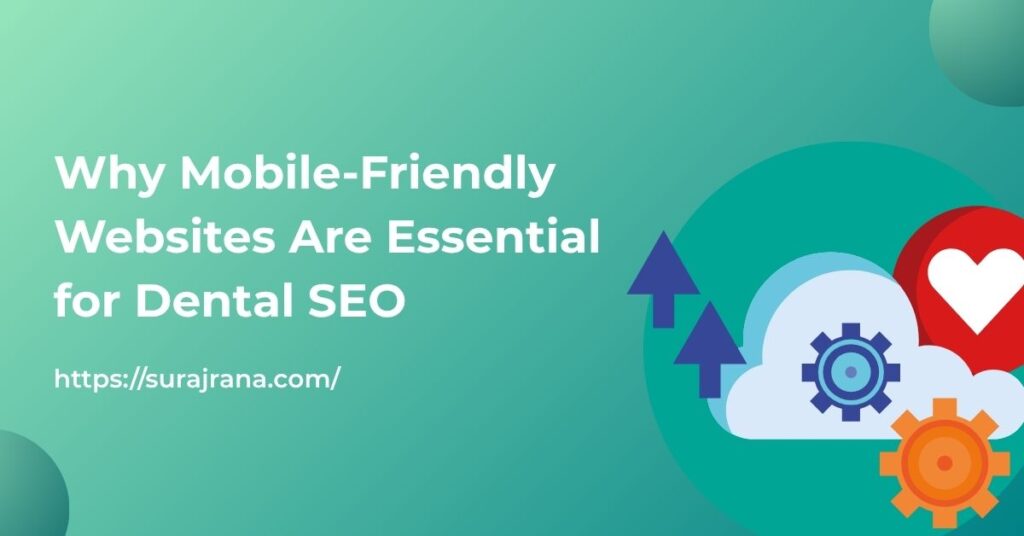Imagine trying to book a dentist on your phone, but the site is slow, the buttons are too tiny to tap, and the page doesn’t even load properly.
Frustrating, right? These issues are more common than you might think—and they can cost dental clinics new patients.
Today, more people use mobile devices than desktops to search for local services, especially when they’re in a hurry or in pain.
That’s why having a mobile-friendly website is no longer a bonus—it’s a must. In this article, we’ll look at how mobile design affects search rankings and why it’s key for helping dentists attract and keep more patients.
What Does “Mobile-Friendly” Really Mean?
Simple Definition
A mobile-friendly website adjusts automatically to fit smaller screens like phones and tablets, making it easy for patients to browse without frustration.
The text appears large enough to read without needing to zoom in, and the buttons and links are spaced well so users can tap them easily with their fingers.
This type of smooth experience isn’t just good for visitors—it also helps your site perform better in search results.
That’s why working with an SEO Agency for Dentists can make a big difference in making sure your website is ready for mobile users and search engines alike.
Why Patients Use Their Phones First
Most people search for a dentist using their smartphone, especially during emergencies when time matters most.
It’s common to see searches like “dentist near me” or “emergency dentist open now” from people who need quick help.
If your website isn’t easy to use on a mobile device—slow loading, hard-to-read text, or tricky navigation—those visitors are likely to leave and choose a competitor with a better mobile experience.
How Mobile-Friendliness Impacts Dental SEO
Google Prioritises Mobile Sites
Google now uses “mobile-first indexing,” which means it checks your website’s mobile version first when deciding how to rank it in search results.
So, even if your desktop site looks great, a poor mobile experience can still drag down your SEO performance.
On the other hand, a mobile-optimised site boosts your chances of appearing on the first page, helping more potential patients find your clinic when they search online.
Bounce Rate and User Experience
A confusing or slow mobile site often causes visitors to leave almost immediately—this is known as a high bounce rate.
When people don’t stick around, Google sees it as a sign that your site isn’t helpful, which can hurt your rankings.
But when your website is mobile-friendly, loads quickly, and is easy to use, visitors stay longer and interact more, which sends positive signals to Google and improves your SEO performance.
Real-Life Benefits for Dentists
More Local Patients
Mobile searches often lead to fast action—especially when someone is in pain or needs help quickly.
For instance, a person with a toothache is likely to call the first dental clinic they find online. A mobile-optimised site with features like click-to-call makes it simple for patients to get in touch without any hassle.
Being prepared for these quick decisions can lead to more appointments and help your clinic grow, especially when combined with a strong dental SEO that improves your visibility in local search results.
Builds Trust and Credibility
A clean, modern website creates a strong first impression and shows that your clinic is up to date and trustworthy.
On the other hand, if your site looks outdated or doesn’t function well on a phone, potential patients might question the quality of care you provide.
A professional online presence builds confidence in your practice before a patient even walks through the door.
What a Mobile-Friendly Dental Website Should Include
Clear Contact Info and Tap-to-Call Buttons
- Place your phone number at the top of every page.
- Use “tap-to-call” so users can contact you without typing or copying.

Fast Load Times
- Websites should load within 3 seconds on mobile.
- Compress images, avoid too many animations, and clean up unused scripts
Easy Navigation
Menus on your mobile site should be easy to find and simple to use, even with one hand. Visitors shouldn’t have to scroll sideways or zoom in just to read or tap something.
Key information like booking options, your clinic’s location, and the services you offer should be accessible within just a tap or two.
Tips to Improve Your Dental Website for Mobile
Use Responsive Design
Responsive design means your website automatically adjusts to fit any screen size—whether it’s a phone, tablet, or desktop.
This approach is more effective than creating a separate mobile site, which can be harder to manage and keep up to date. With responsive design, you only need one version of your site that works well everywhere.
Test Your Site on Different Devices
Try opening your website on different phones and tablets to see how it looks and feels from a patient’s point of view.
This simple step can reveal layout issues or buttons that are hard to tap. You can also use free tools like Google’s Mobile-Friendly Test to quickly check your site’s performance and find out what needs improvement.
Keep Forms Short and Simple
Patients don’t enjoy typing a lot on small screens, especially when they’re in a hurry or feeling uncomfortable.
That’s why your mobile forms should be short and simple. Only ask for the essentials—like name, phone number, preferred appointment time, and reason for the visit—to make the process quick and stress-free.
SEO for Dentist Clinics: Mobile Is No Longer Optional
Voice Search and Mobile Use
Many people now use voice tools like Siri or Google Assistant to find dentists quickly and easily.
These voice searches are typically done on mobile devices and often lead to immediate actions, like calling a clinic or booking an appointment.
Mobile-friendly websites are more likely to show up in voice search results because they offer a faster, smoother experience that matches what search engines and users expect.
Local SEO and Mobile Go Hand in Hand
Google Maps, business listings, and “near me” searches all rely heavily on mobile use. When someone searches for a nearby dentist, features like “call now,” “get directions,” and displaying your open hours are powered by how well your mobile-friendly site functions.
A smooth mobile experience not only improves usability but also plays a key role in Dental SEO, helping your clinic appear in local search results and stand out to people searching in real time.
Conclusion
Mobile-friendly websites are a must for any dental clinic hoping to rank higher in search results and book more patients.
With more people searching on mobile devices than ever before, Google now focuses more on your mobile site than your desktop version.
A site that’s easy to use on a phone means smoother visits for patients, builds trust, and leads to better rankings. If you’re unsure whether your website meets today’s mobile standards, take a few minutes to test it—or ask for help.
Digital marketers like Suraj Rana understand how to connect mobile performance with real SEO growth and more patient bookings. Now is the perfect time to improve your mobile site and give your clinic the online boost it deserves.

My name is Suraj Rana, and I am a seasoned Dental SEO Specialist with extensive experience in the Dental SEO industry. Leveraging my deep knowledge and expertise, I help dental practices enhance their online visibility and attract more patients.


